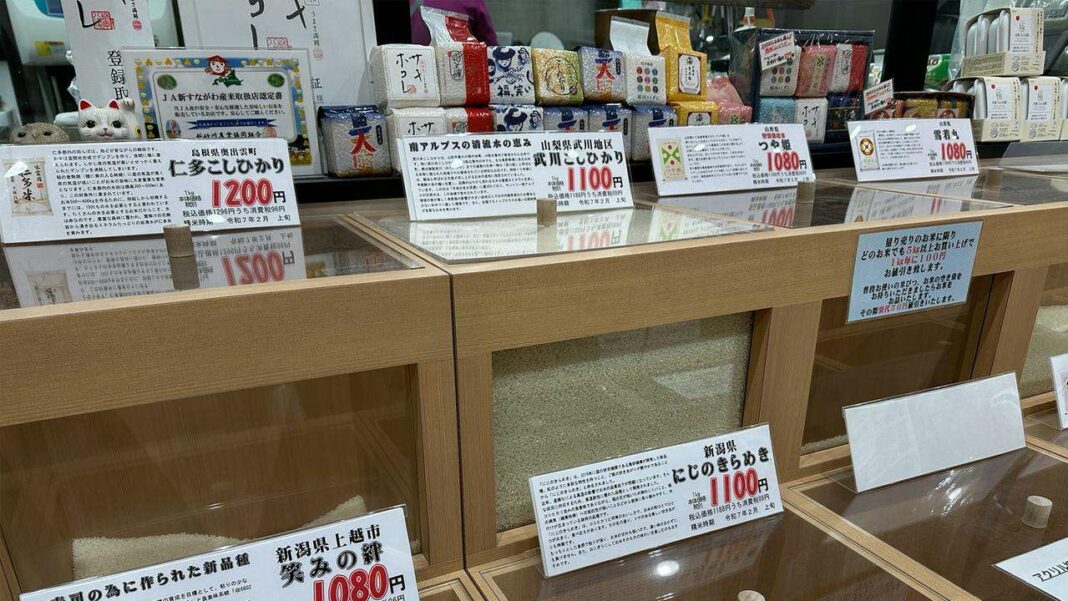Recent poor harvests and rising prices have prompted the Tokyo government to tap into its rice reserves for the first time. Prices have surged dramatically, with some rice now costing over 1,000 yen per kilogram. Agriculture Minister Taku Eto has announced the auction of 210,000 tons from reserves to stabilize the market. Despite Japan’s self-sufficiency in rice production, challenges such as climate change and government policies have led to scarcity, pushing prices higher and raising concerns among consumers.
Poor harvests, panic buying, and soaring prices have led the Tokyo government to tap into state rice reserves for the first time. Is Japan’s beloved staple food turning into a luxury item?
As Ichiro Kokubo skillfully maneuvers his forklift outside his store on the outskirts of Tokyo, everything seems normal. He is busy shifting tons of rice bags around, and his warehouse is brimming with various rice types sourced from across Japan. The rice expert takes pride in showcasing his inventory.
However, a closer look at the prices in his shop reveals a different picture. For the first time, four-digit numbers appear on the price tags: One kilogram of rice now costs over 1,000 yen (approximately 6.30 euros). Just a year ago, the same amount would have set you back just over four euros, showcasing a dramatic shift.
In some instances, prices have surged by as much as 80 percent. While Japanese rice has traditionally been on the pricier side compared to international standards, this unprecedented price spike is alarming.
For nearly three centuries, futures contracts for rice prices have been traded at the Dojima derivatives exchange in Japan.
210,000 Tons Set for Auction
In response to rising concerns among sushi lovers, mochi fans, and sake drinkers, Agriculture Minister Taku Eto has taken a bold step. In mid-February, he announced that the government would release portions of its rice reserves for the first time to help stabilize prices. An initial 210,000 tons are slated to be auctioned to wholesalers.
These reserves are typically reserved for particularly poor harvests or to ensure food supply during natural disasters. This time, however, the objective is to meet Japan’s need for affordable rice.
Minister Eto reassured citizens by stating, “There is certainly enough rice in Japan to satisfy demand.” He added that the main issue lies in distribution. But is that the whole story?
Market Speculation on the Rise
The reality is that the summer of 2023 saw disappointing harvests, and 2024’s yield was only average. Climate change continues to create challenges for rice farming, leading to declining quality. Many farmers are opting to sell their rice directly to customers rather than through large agricultural cooperatives, making high-quality rice increasingly scarce. This scarcity attracts speculators, further inflating prices.
Japan enjoys nearly complete self-sufficiency in rice production, yet the notion of importing cheaper rice is met with national pride, making it a complicated issue. A significant part of the problem lies in the stringent government regulations surrounding rice cultivation.
Kimio Inagaki, a research director and authority on Japan’s food and agriculture sector, has criticized the government’s rice policies. He argues that excessive subsidies are allocated to feed rice and other crops, leaving farmers who can produce edible rice without any state support. This lack of assistance discourages rice cultivation, according to Inagaki.
The government also restricts cultivation areas. Although the official policy to reduce these areas ended in 2018, there are still few incentives for farmers to utilize their fields fully. Japan could potentially produce much more rice than its current output of 6.8 million tons in 2024.
Anxious Anticipation for the Upcoming Harvest
This situation has not gone unnoticed among the public. Rice master Ichiro Kokubo mentions that some customers begrudgingly pay the higher prices, while others are starting to skip Japan’s staple food altogether. “Rice is like the air we breathe for the Japanese,” Kokubo shares with a smile.
Despite the rising prices, Kokubo has not seen a significant drop in sales, partly because he consistently keeps his shelves stocked, unlike many larger supermarkets in the vicinity. “Customers are rediscovering our small rice shops,” he notes.
Kokubo generally supports the government’s decision to release rice reserves but doubts that prices will drop significantly as the Ministry of Agriculture plans to buy back the same amount later. The rice crisis in Japan shows no signs of abating, and much will hinge on this year’s harvest. For now, Ichiro Kokubo’s warehouse remains filled to the brim.
